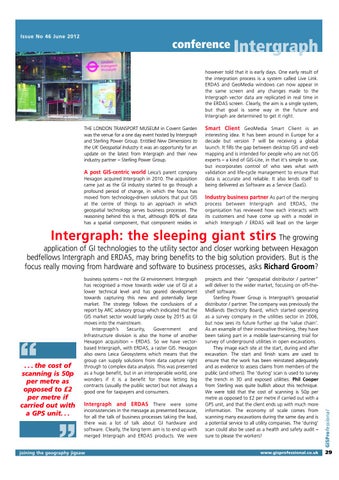Issue No 46 June 2012
conference Intergraph however told that it is early days. One early result of the integration process is a system called Live Link. ERDAS and GeoMedia windows can now appear in the same screen and any changes made to the Intergraph vector data are replicated in real time in the ERDAS screen. Clearly, the aim is a single system, but that goal is some way in the future and Intergraph are determined to get it right. THE LONDON TRANSPORT MUSEUM in Covent Garden was the venue for a one day event hosted by Intergraph and Sterling Power Group. Entitled New Dimensions to the UK Geospatial Industry it was an opportunity for an update on the latest from Intergraph and their new industry partner – Sterling Power Group.
A post GIS-centric world Leica’s parent company Hexagon acquired Intergraph in 2010. The acquisition came just as the GI industry started to go through a profound period of change, in which the focus has moved from technology-driven solutions that put GIS at the centre of things to an approach in which geospatial technology serves business processes. The reasoning behind this is that, although 80% of data has a spatial component, that component resides in
Smart Client GeoMedia Smart Client is an interesting idea. It has been around in Europe for a decade but version 7 will be receiving a global launch. It fills the gap between desktop GIS and web mapping and is intended for people who are not GIS experts – a kind of GIS-Lite, in that it‘s simple to use, but incorporates control of who sees what with validation and life-cycle management to ensure that data is accurate and reliable. It also lends itself to being delivered as Software as a Service (SaaS).
Industry business partner As part of the merging process between Intergraph and ERDAS, the organisation has reviewed how each interacts with its customers and have come up with a model in which Intergraph / ERDAS will lead on the larger
Intergraph: the sleeping giant stirs The growing
“
. . . the cost of scanning is 50p per metre as opposed to £2 per metre if carried out with a GPS unit. . .
business systems – not the GI environment. Intergraph has recognised a move towards wider use of GI at a lower technical level and has geared development towards capturing this new and potentially large market. The strategy follows the conclusions of a report by ARC advisory group which indicated that the GIS market sector would largely cease by 2015 as GI moves into the mainstream. Intergraph’s Security, Government and Infrastructure division is also the home of another Hexagon acquisition – ERDAS. So we have vectorbased Intergraph, with ERDAS, a raster GIS. Hexagon also owns Leica Geosystems which means that the group can supply solutions from data capture right through to complex data analysis. This was presented as a huge benefit, but in an interoperable world, one wonders if it is a benefit for those letting big contracts (usually the public sector) but not always a good one for taxpayers and consumers.
Intergraph and ERDAS There were some inconsistencies in the message as presented because, for all the talk of business processes taking the lead, there was a lot of talk about GI hardware and software. Clearly, the long term aim is to end up with merged Intergraph and ERDAS products. We were
“
joining the geography jigsaw
projects and their “geospatial distributor / partner” will deliver to the wider market, focusing on off-theshelf software. Sterling Power Group is Intergraph’s geospatial distributor / partner. The company was previously the Midlands Electricity Board, which started operating as a survey company in the utilities sector in 2006, but now sees its future further up the ‘value chain’. As an example of their innovative thinking, they have been taking part in a mobile laser-scanning trial for survey of underground utilities in open excavations. They image each site at the start, during and after excavation. The start and finish scans are used to ensure that the work has been reinstated adequately and as evidence to assess claims from members of the public (and others). The ‘during’ scan is used to survey the trench in 3D and exposed utilities. Phil Cooper from Sterling was quite bullish about this technique. We were told that the cost of scanning is 50p per metre as opposed to £2 per metre if carried out with a GPS unit, and that the client ends up with much more information. The economy of scale comes from scanning many excavations during the same day and is a potential service to all utility companies. The ‘during’ scan could also be used as a health and safety audit – sure to please the workers!
www.gisprofessional.co.uk
GiSProfessional
application of GI technologies to the utility sector and closer working between Hexagon bedfellows Intergraph and ERDAS, may bring benefits to the big solution providers. But is the focus really moving from hardware and software to business processes, asks Richard Groom?
29
